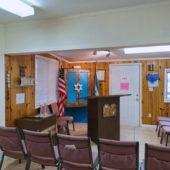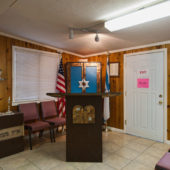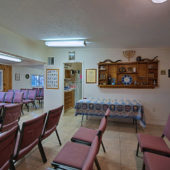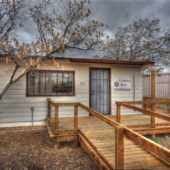An active lay led congregation whose gradual growth is underpinned by Sierra Vista’s sunbelt location and the presence of Fort Huachuca, a large military installation.
Jews began trickling into Southern Arizona in the mid 1800s, largely because of the merchandising opportunities. Some opened general stores, others obtained Indian trading licenses, and still others served as contractors for the U.S. Army. In the 1880s, there were approximately 50 Jews in Arizona. People came to Arizona to make their fortunes and Jewish men often sought either German or eastern Jewish women from back east for their brides. Jews in Southern Arizona were elected to civic and mayoral positions. However, most of the families who were successful ended up leaving, due to the unbearable heat. Alternatively, some people began moving to the area because the dry air was beneficial for their health. The Jews of Southern Arizona were growing in cultural awareness by the late 1880s. The Hebrew Ladies Benevolent Society was founded in 1884. Twenty years later this same society raised funds to build a permanent synagogue in Tuscon, donated from settlers not only in Tuscon, but also in nearby towns. In October of 1910 the synagogue was completed.
In 1877, at the base of the Huachuca Mountains, the U.S. established one of the most important military posts for American expansion into the southwest frontier. Soldiers had been stationed in the area for decades. Huachuca is a Native American word meaning, “place of thunder,” describing intermittent electrical storms in the area – with only the skies booming. Today, Ft. Huachuca base is a center of innovative military intelligence.
By 1924 there were 480 Jews in Tuscon (75 miles away from Sierra Vista). During WWII the population grew, because an air force base was established in Tuscon. By 1948 there were 4000 Jews. The congregation grew out of the original building and into larger facilities by 1949. In the 1950s air conditioning in homes became standard, which made life in Arizona much more tolerable. In 1970 there were at least 6,000 Jews in the city. Most Jews in Tuscon are professionals and many are involved in real estate development. There is a strong Jewish community and a survey taken in 2002 indicated that half the Jews in Tuscon participated in the Jewish community activities. In 1982 the original synagogue building was reclaimed for use by the Tuscon-Pima County Historical Commission, the Arizona chapter of the Jewish Historical Society. Plans were made for its rehabilitation and preservation, which were completed in 2007. The Jewish History Museum was opened in 2008 and is located in Arizona territory’s first Jewish house of worship. It was an integral factor of the religious corridor, that grew up on Stone Avenue from the late 1800s to the early 1900s.
In 1979 small group of individuals from Sierra Vista got together and decided to start the synagogue. Prior to that time, services were periodically held at Ft. Huachuacha, AZ. They (approximately 8 to 12 people) met a few times in private homes, but the effort fizzled out. In 1984 approximately 15 to 20 families held bi-monthly Shabbat services in peoples’ homes. Sam and Mary Caron and Simon Rosenblatt joined the small community in late 1984/1985. Sam had led services in college, for his fraternity at ASU. At his Bar Mitzvah, he had been trained to lead services. On December 20, 1985, the first executive board was elected and Jeff Haff was elected President with Eileen Ross as Vice President. The congregation named themselves Kol Hamidbar (A Voice in the Desert).
There was a strong women’s group by 1985, largely due to Eileen’s leadership. She was one of the major forces in establishing the temple. There were approximately ten founding families who continued meeting in homes until Sam and Mary had an office building that became vacant (which was at one time a residence), and they offered that to the temple, its current premises. The building was dedicated on April 23, 1988, at which time the congregation was given, on permanent loan, a Holocaust Torah, from Artia, Westminster (England). This Torah was rescued from Taus-Domazluce. In June of 1988 they became affiliated with the UAHC (Union of American Hebrew Congregations). Because the temple is located near Fort Huachuca many military personnel and their families attend the temple. A congregation in Stubenville, OH bequeathed one of their Torah scrolls to Kol Hamidbar in approximately 1994, because their congregation was dwindling. In May of 1996 a group of eight women (including Mary) together celebrated their Bat Mitzvot and this was celebrated in the local newspaper.
For the first fifteen years of the life of the temple, because there was a large group of children, there was a Sunday school with Bar and Bat Mitzvah classes. These were lay-led. There have been many Bar and Bat Mitzvahs over the years. Then the children grew up. There are some young families who have joined the temple. Presently, there are weekly Shabbat services, led predominantly led by Sam, who became President in 2009. He has continued to lead services since the beginning. Today, he and his wife Mary are the leading forces of this Reform congregation. The services are relaxed. Sam is a ventriloquist and puppeteer, amongst his many gifts. He might bring his puppets to help with the singing or to tell a story. He has one puppet everyone knows, Elwood. Sometimes Sam and Elwood lead the ending hymn, ‘Adom Olom.’ For the holidays, they will have a meal where the temple will provide the main dish and the congregants will bring side dishes. For Hannukah, they had a meal first, then sang Hannukah songs, had the Hannukah service, and then dradles and gelt were passed out. There were about 50 people. It was a fun, joyous time. There are usually 40-50 congregants attending the High Holiday services.
Temple Kol Hamidbar is housed in a one-story building with ivory horizontal siding, featuring a flat brown roof. A welcoming, brown patio-style walkway leads up to the front door. Inside the prayer room, the front half of the room has wood paneled walls and the back half has white walls, with a white ceiling. Large windows are trimmed in white woodwork. The Aron Kodesh is in the front right corner, simply carved of wood in a tall rectangular shape, with a vibrant blue panel down each front door. White handles are craftily carved to shape the Star-of-David in the center. A simple dark wood tivah (reader’s desk) with an inset of wood (shaped as twin tablets featuring The Ten Commandments) is situated in the front of the room. Comfortably upholstered rose- colored chairs sit on ivory tiled flooring, filling the sanctuary.






